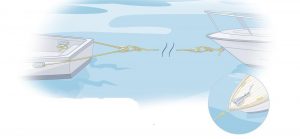Forespar's Point of View
Blogging About Life on the WaterBoat Tow or No?
The obligation to render assistance is as old as the sea. You see another vessel in danger, and you go to help. Generally, there’s no excuse to not at least try, even if it’s a boat tow.
Reasons To Say NO
Even though boats seem to float and drift easily, they’re still heavy. That means some interesting loads on the towing boat. A few thousand pounds of boat at the the end of a lightweight tow line can get “western” in a hurry, even in flat water and no wind. Add some seas or a heavy chop and some real breeze and the tow can go bad quickly.
Most boats have relatively lightweight cleats, and most boaters don’t carry heavy lines – snapping lines and ripped out cleats aren’t helping your boat, or the boat you’re trying to help. It’s also likely that your power and props are just fine for motoring, fishing or skiing, and just aren’t suited for generating the torque necessary for towing a heavy load at lower speeds. Think about pulling another car on a wet road, spinning your tires the whole way. Probably not a good idea.
What About the Line?
A tow line should be eight or ten boat lengths (call it 250 to 300 feet) if you’re pulling a 30 foot boat. Most pleasure boats don’t carry line long enough or strong enough for serious towing. If you do have line, the worst to use is the standard three-strand nylon, since it has too much stretch, and tends to part explosively under load. Double-braided nylon is a better choice, but like any line that sinks, you’ll run the risk of fouling your props, if you allow too much slack. Your best bet is probably your anchor line, as it’s usually the longest and strongest line aboard.
Points and Cleats
Before you use that cleat or pad eye, first make sure it’s up to the task at hand. A too small cleat (even sometime a Forespar), a cheap cleat or poor installation can and will break, and can become a lethal missile if it snaps under load. Then, when you’re setting up the tow rig, use a “bridle” set forward with the length of each leg at least twice the width of your boat, distributing the tow load to both side of the boat, allowing you to maintain control, since a single line attached to the transom will truly degrade your steering. Then, adjust the tow line length so that your boat and the tow are in sync with the waves and troughs (remember that if you’re towing, the other boat probably doesn’t have brakes, so the tow tine may need to be slightly longer than you think).
A Knotty Issue
Knots used in towing are subject to heavy loads, so avoid knots that cinch tight. Cleat hitches and bowlines are ideal, as they won’t come untied under load, but are easy to release when required. And, no one stands in direct line with a loaded line (or should be dumb enough to straddle it), because if the line or cleat lets go, someone gets hurt.
Wait It Out
If there’s only one thing to take way here, it is to err on the side of caution. If you aren’t very sure of your ability to tow the other boat safely and effectively, don’t do it. The last thing the Coast Guard wants is two boats in trouble at the same place and time. Get on the radio and stand by for help, preferable a vessel with the equipment, know-how and insurance.
And thanks to the U.S. Coast Guard for their guidance, and not least, being ready to help us when and where it’s needed.
